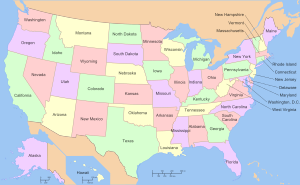 |
It seems to me that one of the appeals of attending a nationally recognized college would be to interact with other students from across the nation. And from a more cynical perspective, it allows that school to be “nationally” recognized.
Out of curiosity, I downloaded the “residence and migration of first-time freshman” from the Integrated Post-Secondary Education Data System (IPEDS) database for a select number of colleges. I picked the colleges based on general prominence and an eye to geographic diversity–no sort of scientific rational involved.
The following table is a list of the 19 colleges (yeah, I should have picked one more just make it a nice even number) and the top five states of origins for their freshman. The number is the percent of all freshman for the college from the United States.
 The shading colors represent the most populous states which are in order
The shading colors represent the most populous states which are in order
- California
- Texas
- New York
- Florida
- Illinois
Given the influence that college rankings appear to have on high school students, I didn’t expect the largest contingent of students to hail from the college’s home state. Only six of the colleges didn’t have their home state as the highest percentage of freshman.
As expected, California and New York are well represented at almost all of the colleges as you would expect two of the three largest states in the nation. New Yorkers get around! They are the second largest group at Davidson, Duke, and Vanderbilt, and third at Rice and Emory. No regional snobbishness on their? part.
Now as for the second most populous state in the country, Texas, what’s the deal?
There are two basic possibilities. The first is that not as many Texas high school students apply to? schools outside their home state compared to students in other states. Therefore, the colleges have fewer Texas students to select from in their applicant pool.
The second possibility is that high school students are proportionally represented but are either not selected by colleges or are selected and choose not to attend.
Which is it? Probably a combination of both. Let’s face it, these are all private schools and they aren’t telling.
But what is interesting is to look at the state SAT reports which list the top colleges that students from the state send their score reports to. In Texas, 2.1% of the students sent their reports to Harvard compared to 2.6% in Florida, 16.9% in Illinois, 3.6% in California, and 5.2% in Massachusetts. The percentage for New York and New Jersey aren’t listed since they didn’t make it to the first page.? That means it must have been 3.2% or less for New York and 3.0% or less for New Jersey.
Obviously, a smaller percentage of high school students in Texas applied to Harvard compared to other states. However, it’s just as clear that Harvard accepts a disproportionate number of students from New York and New Jersey.
As a long time observer of education in Texas, it seems perfectly reasonable to assume that fewer students apply to Harvard and that those that do are not as qualified as those from other states. That brain drain everyone was warning that would happen when Texas implemented the Top 10% rule for UT doesn’t seem to have happened.
However, I think that Texas, and Florida while we’re at it, would benefit from more students leaving the state for college. Just think, in college they could share the virtues of their home states and when they return home they could share different perspectives and ideas with their families and neighbors. Or is that what they’re trying to avoid in the first place?

